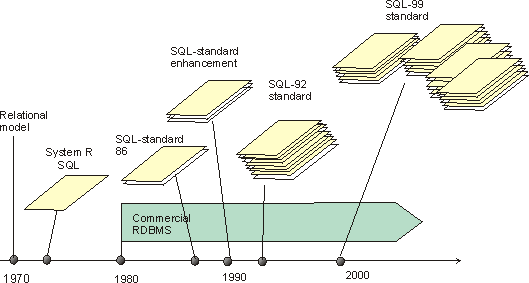

The SQL language was originally developed at the IBM research laboratory in San Josť, in connection with a project developing a prototype for a relational database management system called System R in the early 70s.
The first database management systems based on SQL became available commercially by the end of the 70s. At the same time, relational database management systems based on other languages were published. The best known alternative for SQL was the QUEL language in the Ingres system.
SQL was elected for standardization. Both the American ANSI and the international ISO took part in the standardization
In 1986, the first SQL standard was approved (the core SQL about 40 pages + the module language, and embedding in programming languages, altogether about 100 pages)
In 1989, an integrity enhancement was appproved by ISO, containing, among other features, the specification possibility for keys, foreign keys and some other constraints (c. 20 pages)
In 1992, the new version SQL-92 (also called SQL2) was approved. It contained large enhancements to the language. The size of the standard was about. 600 pages + the data dictionary standard; altogether c. 1000 pages. Three levels were specified for SQL
Instead of one massive standard, the decision was taken to continue development in parts.
In 1995, the SQL/CLI call level interface was approved, i.e. the interface specification for use through programs. The standard specifies the ODBC interface.
In 1996, the SQL/PSM (persistent stored modules) was approved as a database procedure specification language.
In 1999, the new version SQL-99 (also called SQL3) was approved. The standard is divided into five parts.
Altogether, the standard is about 2,100 pages long. It contains large enhancements to the 92 standard, such as new data types, database procedures and triggers, object oriented features, more comprehensive integrity checks, recursive queries, and data warehouse functions. Due to the new features SQL-99 is quite far from the principles of the relational model of data.
The conformance to the standard is no longer based on levels but there is a core, to which additional features can be added as packages.
The embedding of SQL into a Java program (SQLJ) was approved on 2000. At least the standards for multimedia enhancements and data warehouse features are being developed.